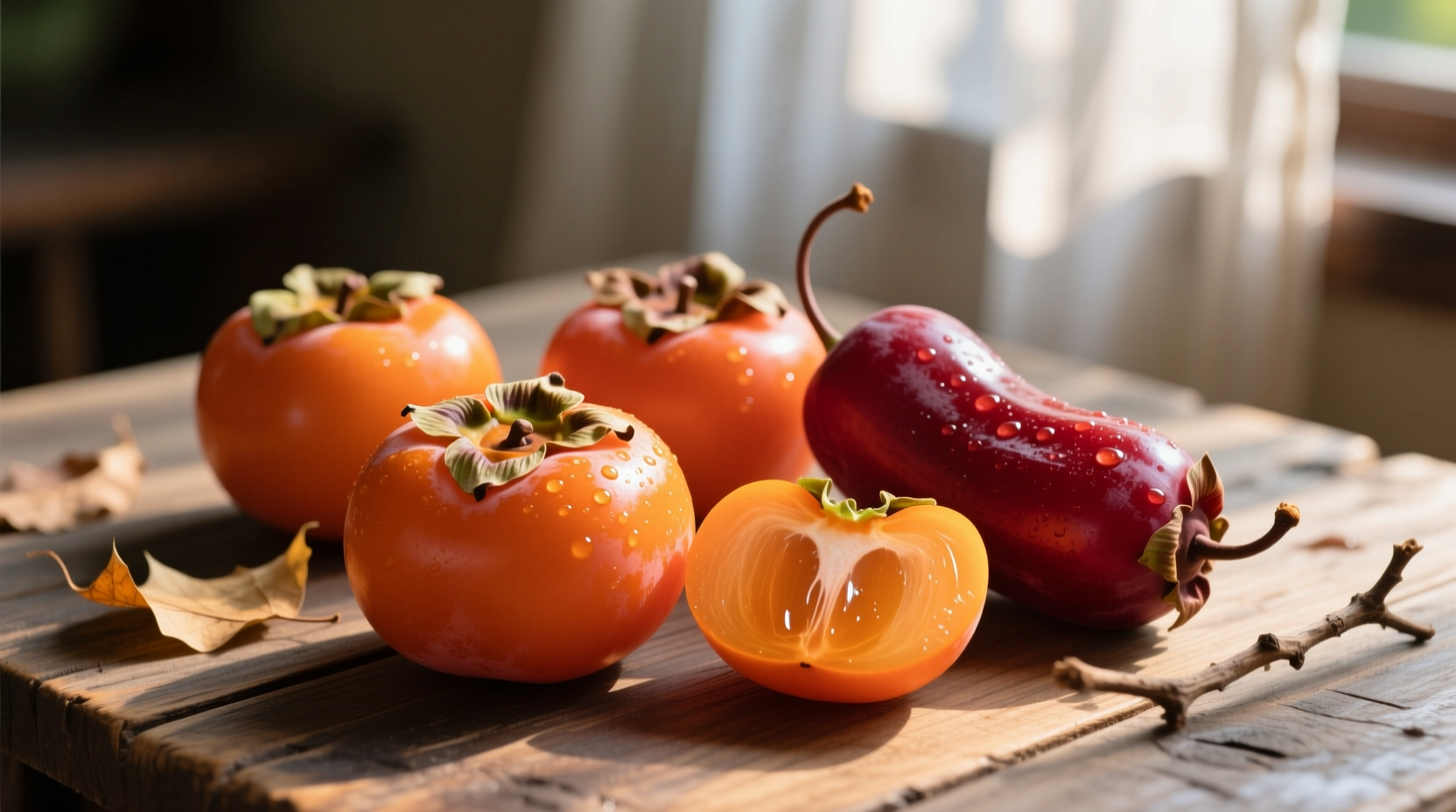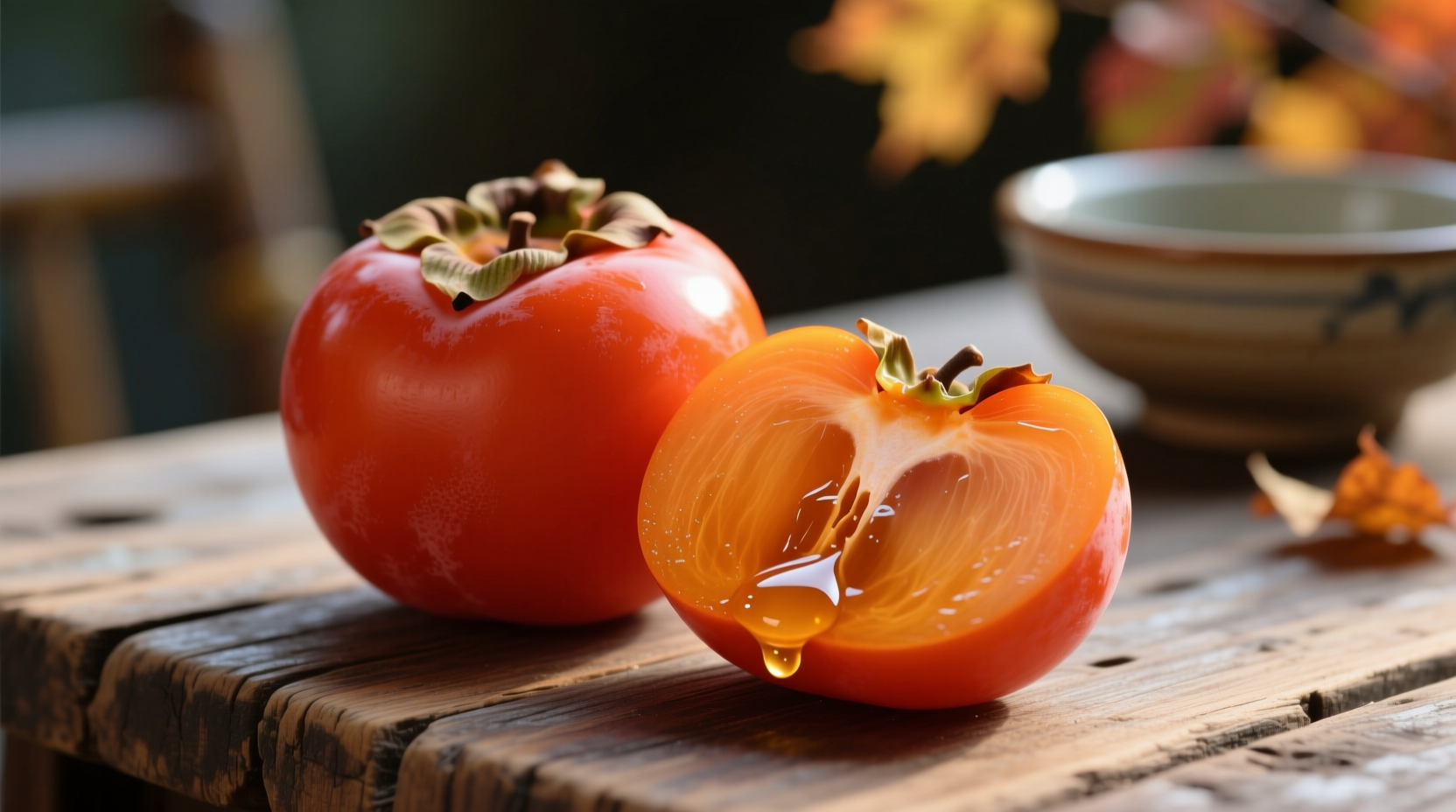Discover exactly what to expect when biting into this unique fruit. Whether you've spotted persimmons at your local market or received a mystery box of Asian produce, understanding their flavor profile prevents unpleasant surprises from unripe specimens. This guide breaks down the sensory experience of persimmons by variety, ripeness stage, and preparation method—so you can enjoy them at their absolute best.
Two Distinct Persimmon Types, Two Completely Different Experiences
Understanding persimmon taste starts with recognizing there are two primary varieties with radically different flavor profiles and eating requirements. This critical distinction explains why some people describe persimmons as delicious while others recall an intensely unpleasant, mouth-puckering experience.
| Characteristic | Fuyu Persimmon | Hachiya Persimmon |
|---|---|---|
| Texture when edible | Firm, crisp (like apple) | Jelly-soft, pudding-like |
| Taste profile | Mildly sweet, honeyed pear | Intense caramel, brown sugar, tropical notes |
| Astringency when unripe | Minimal | Extremely high (mouth-drying) |
| Eating stage | Firm to slightly soft | Must be completely mushy |
Why Ripeness Makes or Breaks the Persimmon Experience
The dramatic difference in persimmon taste boils down to tannin content and ripening process. According to research from the University of California Agriculture and Natural Resources, unripe Hachiya persimmons contain soluble tannins that create an intensely astringent, bitter sensation—similar to biting into an unripe banana but significantly stronger.
As persimmons ripen, these tannins polymerize and become insoluble. This biochemical transformation, documented in the Journal of Agricultural and Food Chemistry, is why Hachiya persimmons must reach complete jelly-like softness before becoming enjoyable. The ripening timeline follows this pattern:
- Stage 1 (Firm): Bitter, mouth-puckering astringency (Hachiya only)
- Stage 2 (Slightly soft): Faint sweetness emerging, still unpleasant (Hachiya)
- Stage 3 (Very soft): Balanced sweet-tart flavor (Fuyu)
- Stage 4 (Jelly-soft): Rich, complex sweetness without astringency (Hachiya)

Sensory Breakdown: What Exactly Does a Ripe Persimmon Taste Like?
When properly ripe, persimmons deliver a distinctive flavor experience that's difficult to compare to any single fruit. Food scientists at the USDA have analyzed their complex flavor compounds, identifying notes that explain why persimmons stand in a category of their own.
Fuyu persimmons (eaten firm): Imagine a cross between a crisp apple and a ripe pear, with subtle honey sweetness and delicate floral notes. The texture remains crunchy like an apple but without tartness. Some detect faint cinnamon undertones, especially in certain cultivars.
Hachiya persimmons (eaten ultra-ripe): Think of the most intense sweet potato pie filling blended with mango nectar and brown sugar. The jelly-soft flesh delivers concentrated sweetness with complex layers—reminiscent of caramelized apricots, roasted pumpkin, and tropical fruit. The flavor intensifies dramatically as they ripen beyond the point where most fruits would be considered spoiled.
Common Flavor Comparisons (and Why They're Incomplete)
Many descriptions compare persimmons to other fruits, but these comparisons only capture fragments of their unique profile:
- "Like mango" – Captures the tropical sweetness but misses the honeyed depth
- "Similar to apricot" – Gets the stone fruit notes but not the caramel richness
- "Tastes like pumpkin pie" – Describes the spice-like notes but oversimplifies
The truth? Persimmons have a flavor identity all their own. As noted in USDA nutritional research, their unique combination of sugars (glucose, fructose, sucrose) and volatile compounds creates a taste experience that doesn't perfectly mirror any other fruit.
How to Select and Enjoy Persimmons Without Disappointment
Avoiding the dreaded astringent experience requires understanding seasonal availability and proper selection techniques:
- Fuyu persimmons: Look for bright orange fruit with firm texture. They're ready when slightly yielding to gentle pressure. Eat like an apple—skin on or off.
- Hachiya persimmons: Choose firm specimens and store at room temperature until they become completely jelly-like. The skin will darken significantly. Best eaten by cutting open and spooning out the custard-like flesh.
Persimmons reach peak season from October through February in most regions. According to agricultural data from the USDA National Agricultural Statistics Service, California produces over 90% of U.S. persimmons, with peak harvest occurring in November.
Practical Tips for First-Time Persimmon Eaters
If you're trying persimmons for the first time, follow these guidelines to ensure a positive experience:
- Start with Fuyu persimmons—they're more forgiving and can be eaten firm
- Never bite into an unripe Hachiya (it's unpleasant and can ruin your perception of the fruit)
- For Hachiya persimmons, wait until they're so soft you can barely handle them without breaking the skin
- Chill ripe persimmons for 30 minutes before eating for enhanced flavor
- Pair with lemon juice or yogurt to balance extreme sweetness if desired
How Persimmon Flavor Works in Culinary Applications
The unique taste profile of persimmons makes them versatile in both sweet and savory applications. When properly ripe, their natural sweetness and complex flavor notes complement various preparations:
- Fresh applications: Sliced into salads (Fuyu), pureed into smoothies (Hachiya)
- Baking: Adds natural sweetness to breads, muffins, and desserts without additional sugar
- Savory pairings: Complements duck, pork, and blue cheese in gourmet dishes
- Preservation: Drying concentrates the sweetness into chewy, date-like treats
Professional chefs note that persimmons' flavor holds up well to gentle cooking but loses complexity with high-heat preparation. The Cooking Light test kitchen recommends using Hachiya persimmons as pumpkin substitutes in pies for a more complex flavor profile.
Seasonal Availability and Storage Tips
Persimmons are a true seasonal delight with limited availability:
- Peak season: October through February (varies slightly by climate)
- Storage: Keep unripe Hachiyas at room temperature; refrigerate ripe persimmons
- Ripening hack: Place Hachiya persimmons in a paper bag with an apple to speed ripening
- Freezing: Pureed ripe Hachiya persimmons freeze well for future baking
Understanding these seasonal patterns helps ensure you encounter persimmons when they're at their flavor peak. The California persimmon industry, documented by the California Department of Food and Agriculture, follows this reliable annual harvest cycle.
Frequently Asked Questions
Q: Why do some persimmons make your mouth feel dry and fuzzy?
A: Unripe Hachiya persimmons contain high levels of soluble tannins that bind to proteins in your saliva, creating that unpleasant astringent sensation. This disappears completely when the fruit ripens fully.
Q: Can you eat persimmon skin?
A: Yes, the skin is edible and contains valuable nutrients. Many people enjoy Fuyu persimmons with the skin on. For Hachiya persimmons, the skin becomes very thin and delicate when fully ripe—you can eat it or peel it based on preference.
Q: How do you know when a Hachiya persimmon is finally ripe enough to eat?
A: It should feel like a water balloon—completely soft with no firm spots. The skin will darken to deep reddish-brown and may show slight wrinkles. If you can gently squeeze it without the skin breaking, it's not ripe enough.
Q: Do persimmons get sweeter the longer they ripen?
A: Yes, significantly. As persimmons ripen, starches convert to sugars and tannins polymerize. Hachiya persimmons continue sweetening until they reach complete jelly-like consistency, which is why patience yields dramatically better flavor.











 浙公网安备
33010002000092号
浙公网安备
33010002000092号 浙B2-20120091-4
浙B2-20120091-4